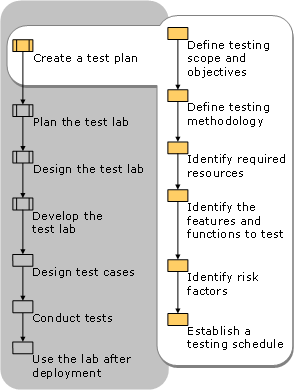Testing Phase:
Unit Testing:
It tests the individual software components of applications. It tests many functions but it confines within in the one unit. The aim of unit test is to leave the interpretation. Test code can be supported by this unit test and it can be sometimes called as scaffolding. The implementation teams and architecture supports this type of unit testing.
It corrects the complete individual program units. It tests the application whether it works properly or not for you are expectations. It identifies the large number of defects during its use. It requires stubs and drivers. The calling unit simulates the driver and called unit simulates the stub. It provides the advantages for stub and driver cost time and money. It reduces the difficulties to identify the errors in complex pieces of application.
Integration testing:
It is the extension of the unit testing. In this testing we can test the two units and these can be combined with the component and it can be tested in middle. The combine the pieces and it can be expanded in another module. In this process is to test all the modules. In this testing the component can be refers as integrated aggregation. In practical, the components are to combine many units which turn the larger part of the program. In this process first test the individual pieces then for expanding the process to test the modules and it can be combine with the other modules. Suppose if the program consists of more than one process at one time it test all the pairs.
It allows the high-level logic and in early stages it tests the data flow and it minimize the need for the drivers.
The integration testing disadvantage is poor performance of the limited functionality.
To test the lowest-level units in the bottom-up approach and it integrates first. The system performance and common mistakes can be found in this testing. These units are named as the utility modules. In the early development process the utility modules can be tested by using this approach and to minimize the stub needs. The test management was complicated by the drivers and high-level logic and data flow can be test in late. It provides the poor performance in the early stages of limited functionality like top-down approach.
System testing:
In this Dissertation process variety of tests can be performed that can used for functional exploration and to identify the problems. It placed before and after the system. After the deployment of the application into the environment the system can perform the test is known as system level testing it is similar to the black box testing and it can be performed by the test engineers. The test team can perform this testing and it controls the system configuration environment.
The main aim of system testing is to complete the designing of the function and to validate the application accuracy. It can apply to real life scenarios and to test the all functions of the system in real life.
It starts depend upon the integration testing to resolve the problems before starting of the system testing software QA can review the all the results of the integration test. The important thing for higher level testing is to understand the unresolved problems at integration test levels.
Acceptance testing:
This is the final stage of the testing the system can perform this test and it delivers to the live environment. It includes the deliverables for software system and mechanical hardware system. The black box test can perform this test.
It represents the result from the system. The correctness can be identified by the customers and review the test scores which can be used to fail the highest priority. The test score should be published by the Acceptance test.
Black-box test:
It is one of the design method and it does use the knowledge of the internal structure. It describes the functional requirements of the testing and it applicable to the functional testing, unit, integration and acceptance and system testing. The drawback of this testing is to uncover the specification of the unimplemented parts we are not sure that all existent paths are tested.
White box testing:
It examines the output by using the programming code knowledge to examine the outputs.
The software developer can design the MS Final Year Project test cases by using this white-box testing.
- To update the logical decisions at the both sides such as true and false.
- In module or unit to exercise the independent paths.
- Loops can be executed at their boundaries within their operational bounds.
Test plan:
The open source community can be provided by this test plan and it delivers the customer workloads and it delivers the test suites. The defects can be verified through the regression testing.
The team of the testing creates the test plan in the early deployment planning phase. It defines the scope and objectives of the testing efforts and identifies the methodologies and to conduct the tests by the team. It can test the hardware and software tools of the testing.
To divide the test team into sub team and the sub team can be developed by the test plan in the area of specific technology. The features of the testing network can be written by the network team for test plan.
Test plan creation:
This Paper is written & submitted by Chandu.

